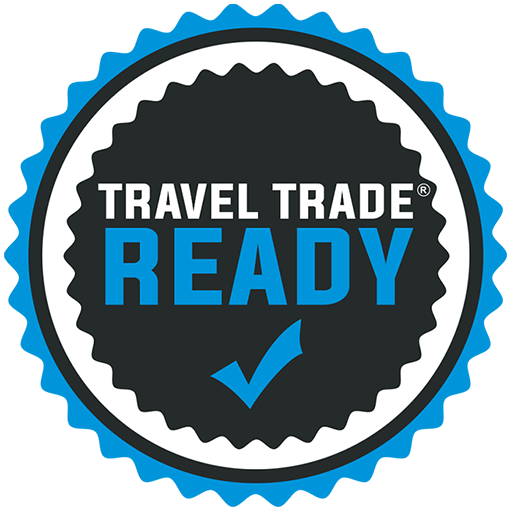Optimising Tourism: An Example of Travel Trade Integration
This blog post explores an effective example of travel trade integration, illustrating how destinations can enhance their global reach and market presence by becoming Travel Trade Ready. In it we’ll look closely at the benefits of understanding the travel trade market, as well as travel experiences and products to achieve sustainable tourism growth. In this example of travel trade integration, we will be specifically showcasing how becoming Travel Trade Ready can revolutionise marketing strategies and enhance connections within the tourism industry.
A Definition and an Example of Travel Trade
The travel trade encompasses the entirety of businesses and individuals who make tourism products available to consumers through various distribution channels. To give a clear example of travel trade as a business sector, imagine a coastal town that packages its beach resorts, water sports, and seafood dining into an attractive offer marketed through European travel agencies focusing on beach holidays. This package effectively reaches potential tourists who may not have discovered the destination through direct searches or advertisements.
Understanding the Travel Trade Landscape
Before we dive into the specifics, let’s set the stage by understanding what the travel trade encompasses. At its core, the travel trade refers to the network of professionals and organisations that promote and sell travel-related products and services, including tours, accommodation, and transportation. It’s an ecosystem that connects destinations with outbound travel agencies, tour operators, and other buyers in the tourism sector. For a closer look at the travel trade industry, check out this detailed overview establishing what travel trade is in tourism.
The Importance of Being Travel Trade Ready
So, why should destinations and service providers seek to be Travel Trade Ready? Simply put, it equips them with the necessary tools and knowledge to market their offerings effectively through travel trade channels, enhancing their visibility and desirability to global travel buyers..
An Example of Travel Trade Integration
Let’s consider a hypothetical example of travel trade integration where a mid-sized city in Europe leverages Travel Trade Ready strategies to attract more visitors. The city, known for its rich history and vibrant culture, previously struggled to reach potential tourists beyond its region. By becoming Travel Trade Ready, it gained access to a network of travel trade professionals and was empowered to begin tailoring its offerings to suit market-specific needs and preferences.
Step 1: Market Analysis
The first step in their strategy involved conducting thorough market analyses to understand which aspects of their city appealed most to various segments of travellers. This analysis was guided by resources like our piece on revolutionising travel trade marketing, which provided insights into emerging travel trade trends and buyer preferences.
Step 2: Product Development
Based on the analysis, the city developed tailored travel packages highlighting unique experiences that ranged from culinary tours to heritage walks, ensuring they catered to the niches identified in their market research. Each package was designed with the travel trade in mind, and formatted to be easily marketed by travel agents and tour operators involved in the travel trade.
Step 3: Engagement with Travel Trade Organizations
With their market-ready products, the next move was to actively engage with travel trade organisations. Workshops, webinars, and trade shows became the city’s playground for showcasing their offerings. They provided comprehensive training materials and sales kits to ensure travel trade professionals could effectively promote the city’s attractions.
Results and Continuing Efforts
As a result of these integrated efforts, the city saw a noticeable increase in tourism traffic, with a significant rise in bookings via travel trade channels. This example of travel trade strategy shows how this way of working can open new markets, as well as building lasting relationships with travel trade professionals, ensuring sustained interest and promotion.
This example of travel trade showcases how effective integration with Travel Trade Ready practices can lead to remarkable results in the tourism industry. For more examples and in-depth discussions on the travel trade, visit our guide to travel trade industry insights.
Moving Forward
The journey of becoming Travel Trade Ready does not end with initial success; it’s an ongoing process of adaptation and learning. In the next section, we will explore how continuous engagement and innovation in travel trade practices can sustain and enhance the tourism industry’s growth.
Exploring the Travel Trade Market
The travel trade market comprises a vast network of professionals and organisations involved in promoting, selling, and distributing travel-related products and services. This market is crucial for destinations and service providers looking to extend their reach beyond local and national borders. As an example of travel trade strategy, destinations often collaborate with travel agents, tour operators, and online travel agencies (OTAs) to create comprehensive, appealing travel packages that cater to diverse traveller needs and preferences.
Defining Travel Trade Experience
A travel trade experience refers to the personalised and packaged travel activities and services sold through travel trade channels. These experiences are designed to meet the specific desires of different market segments and can range from luxury stays to adventure activities, cultural tours, or wellness retreats. An excellent example of travel trade experience might include a guided historical tour of a city, combined with local culinary experiences, reserved through a travel agent specialising in cultural tourism.
Example of a Travel Product
An example of travel trade products could be a multi-day tour package that includes hotel accommodations, guided tours, meals, and transportation. These packages are often tailored to specific interests such as eco-tourism, where travellers can enjoy sustainable tourism activities like bird watching, hiking in national parks, and participating in local conservation efforts. This product is not only appealing but also promotes responsible tourism practices through travel trade channels.
Leveraging Travel Trade for Sustainable Growth
By integrating with travel trade, destinations and providers can ensure that their products are not just seen but experienced by a global audience. This strategy allows for the broadening of market reach and the enhancement of tourist satisfaction through well-curated experiences. Moreover, an example of travel trade like our hypothetical European city demonstrates the potential for sustained growth and development in the tourism sector by continuously adapting to market trends and traveller preferences.
Embracing the Future of Travel Trade
As we’ve navigated through the intricacies of the travel trade, it’s clear that understanding and integrating with this market is essential for anyone looking to elevate their presence in the tourism industry. Each example of travel trade above illustrates not just its potential, but its necessity in a world where travel preferences are continually evolving and diversifying.
By becoming Travel Trade Ready, you can ensure that your destination or service is not only visible but also vibrant and viable in the competitive market. The travel trade offers a structured yet dynamic pathway for reaching global audiences effectively and sustainably. Harnessing this power through well-thought-out strategies and experiences can lead to significant returns, both in visitor numbers and in the richness of the tourist experiences offered.
We invite you to witness firsthand the potential of travel trade integration. Visit the Travel Trade Ready demo site for more on practical applications and innovative solutions that can transform how you interact with and benefit from the travel trade industry. Don’t just take our word for it; explore the possibilities and see how your business or destination can become more connected, more visible, and more successful in the vast world of tourism.


